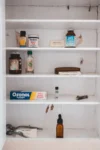I learned from both my nan and great aunt early on that there is no place called “AWAY’, when we throw things away.
The cheaper disposable consumables we tend to use these days have a much shorter lifespan and are of poorer quality than their ‘built to last’ counterparts. The more of an item we use, the more we usually buy and then end up sitting in landfill.
Following on from my research on Compostables I’ve had time in the last month or so to find and trial many reusable products.
Reusables not only fulfill a purpose (or several) without contributing further to our global garbage problem, they can also save quite alot of money over time and reduce valuable space around the home.
Most of the reusable products I have commissioned over the last few months last for years in most cases and I LOVE that only one purchase, craft project or op-shop discovery is all it takes to walk a greener path.
Some reusables are even flexible enough to take on more than role in the home – reducing clutter, expense and giving you back valuable space in your home!
Here are 15 of my favourite and most used reusable household products. These are the ones that made the most difference in cutting our weekly/monthly rubbish.
Although I have included pictures of products that closely match the ones I have transitioned to, I have not included brands or stockists – I’ll leave that part to you!
1. Tea Infuser
This little gem retails for around $3-$5. Not only am I so happy not to have to deal with tea bags, tags, staples and packaging anymore, but buying my tea in bulk and using this infuser over and over again means that I save around $300 per year! (I am a tea addict)
2. Coffee/Travel Mug
There are so many reusable travel mugs on the market it is difficult to choose just one. Making my beverages at home and taking this mug, and with Mr Greenfoot doing the same, we will save around $2000 in the next 12 months (based on x2 cups of tea or coffee each day per person)
3. Non-Stick baking Sheet
When I stumbled across this reusable baking sheet I was skeptical. But I have to admit that I am happy after testing it out. I’ve baked bread at 250 degrees, lined a spring form pan and baked a cake, lined a loaf tin for gluten free baking and everything was a success. This can be used up to 1000 times which for me is around 2 years of baking. This has become one of my most cherished reusable finds. This baking sheet replaces grease proof paper and foil. I love it! No more toxic baking waste to be thrown into the garbage can and I’ll save around $110 in the next 2 years!
4. Produce bags
These calico or organic cotton produce bags can be found easily on the web. I used an old white cotton sheet for mine so they were free. Either way, purchasing my pantry goods in bulk now means that ingredients can be transported home and be put straight into my glass storage jars with absolutely no waste.
Brown paper bags which are normally on hand at produce and health food stores still rely on tree pulp and many draining resources to produce them. They really aren’t eco friendly despite how they look.
I’ve been washing my bags after every 2-3 shops and it is really nice not to have a mound of plastic or paper packaging to deal with. There is not really a monetary saving with these, but I love that many resources are spared by making this transition!
5. Shopping Totes
I have some made from recycled parachute silk and some from a waxed hemp fibre.
As long as we are all saying NO to plastic and paper and those creepy fake green and blue just-as-bad bags then we will all be making a difference. My kitchen is much less stressful without bags of all kinds of shapes and sizes for me to try and find a re-use for.
Bag-free is Glee!
6. Sandwich Wraps
We’ve always tried to use lunchboxes to transport lunches, but sometimes their is no escaping the fact that a good sanger needs to be packaged properly. This style of wrap is what I went for and they are great.
No spillage and the contents don’t seem to have fallen out everywhere at the end of the journey.
I do still use compostable cling wrap on the very odd occasion, but overall these wraps will have saved us around $50 a year (and no more exposure to toxic chemicals that are sprayed on the conventional plastic wrap.)
7. Glass Storage Jars
I was in a very lucky position where I didn’t have many plastic containers to re-house to make this change. This conversion was particularly fun because I was able to take my time and find a mixture of vintage, preserving and sturdy Italian made jars.
Now that my kitchen has been renovated, I have just the place to display them, and filled with dried legumes, rices, flours and herbs makes my kitchen all the more homely.
Being able to make my own nut butters, sauces, oat and rice milks etc means that there are absolutely no stray containers or other plastic remnants to discard to the rubbish bin. For this saving I calculated the savings on not buying disposable or short lasting storage containers as well as plastic food packaging.
By switching to glass, stainless steel containers etc a general family will save around $400 per year (and untold resources).
8. Stainless Steel Water Bottle
This pretty much speaks for itself.
The stainless steel bottles we have at home have lasted a couple of years and do not break down. So no toxic exposure or having to replace every few months.
I’ve put this at a saving of around $1000 per year (based on a general family’s average purchased water consumption). There are also massive health benefits from switching to drinking water and avoiding the breakdown of plastic bottles.
9. Cloth Napkins/Tablecloths
We rarely use paper napkins, only really on birthday occasions where we are outdoors in which case we’ve used recycled paper ones.
Still, I had the time of my life scouring op-shops and the like for vintage napkins and tablecloths. Of course vintage and antique stores are great (but charge an arm and a leg!) and for the budget conscious you can pick up cheap organic and conventional cotton tableware cheaply enough.
For me I usually tend to hunt for 2nd hand firstas the thought of discovering another item that may already be sitting pre-loved and waiting for me elsewhere gets me every time.
The savings for us on these work out at around $30 per year.
10. Kitchen/Cleaning Cloths
This came as a surprise to me. Although I use compostable cloths or old rags in the kitchen mainly, we would still be saving around $50 per year! When testing out reusable kitchen cloths and cleaners, I found that by using a textured cloth, a little hot water and some castille soap, bi-carb or pure vinegar on dirty dishes and my stainless pans and bakeware, I no longer needed to buy scourers or sponges.
11. Cloth Breast Pads
Although I wont be using these forever, the need for these in my household is still current.
Having 2 babies close together means our house has almost been overrun with breast pads! In switching to cloth ones early on, I have managed to save myself $200 this time around. Yay!
12. Cloth Menstrual Pads
Miss teen Greenfoot and I were the only ones affected by this switch. I must say though that I’m glad we made it.
The change was daunting at first, but given I was already dealing with cloth nappies, wipes, handkerchiefs and breast pads, what was one more cloth item to throw into the mix!
By switching to a set of these, we’ll save a combined amount of $250 per year. If you use these post-partum or choose to use a combination of a silicone menstrual cup and some light cloth liners (below) you’ll save loads more!
13. Menstrual Cups
Crunching the numbers on these made me happy. These little wonders work out at around $5 per year and last $10 years!! I love that this and a couple of cloth liners is all we need now. No more stocky paper, boxes and other fiddly and wasteful packaging. Hooray!
14. Cloth Nappies and Wipes
The savings by using cloth nappies was astounding.
I have 2 little ones in nappies and could not imagine contributing my girls waste to the landfill. It made me feel sick. Calculating costs also made my efforts worth the while. It’s nice to walk into my girls nursery and NOT have a stinky nappy bin sitting around. With flushable liners, cloth wipes and a homemade squirty tap, managing nappies is a sweet-smelling breeze. The overall savings are around $5700 for x2 children in nappies until the age of 2. Crazy right?!
15. Real Handkerchiefs and Neti Pots
Apart from finding some beautiful vintage handkerchiefs to fall in love with, not having to deal with tissues all over the floor and empty tissue boxes during cold and flu season is also wonderful!
I made some special flannel hankies out of a baby sheet which are so soft and gentle on little noses. We only pull out the Neti Pot when noses are super blocked and need some flushing.
Although we have managed to escape both colds and flu this year (so far touch wood!) we are ready. I’ve averaged this saving at around $150 (not including sniffle season).
For those who are on a tight budget and/or prefer to hand make and sew, there are many patterns on the internet for the following reusables. I will be writing soon on Repurposing so will have many links for you then.
I still cant believe that our Zero Waste adventure has saved us so much money and wastage so far!

